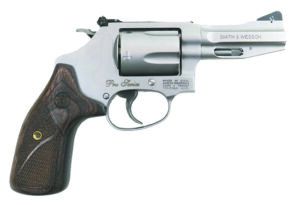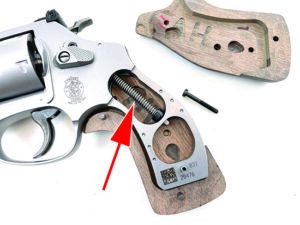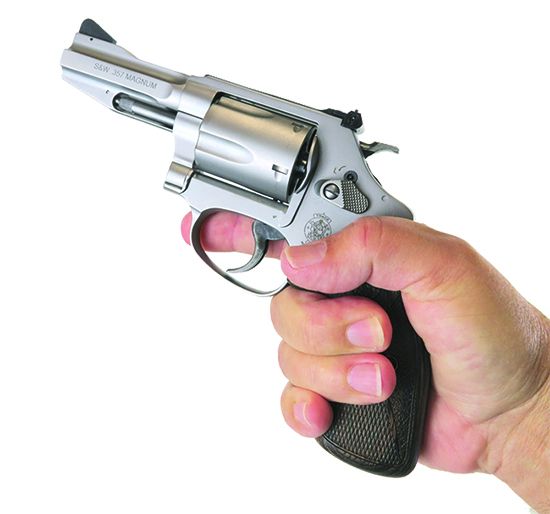You would be hard pressed to find something more effective in a defensive situation than a 357 Magnum revolver. The cartridge provides more velocity and energy than the more popular 9mm Luger round. The 9mm and 357 Magnum both use similarly-sized bullets, but because the 357 Magnum case is longer, it can hold more powder, which translates to about 30 percent more velocity, and depending on the load, about 70 percent more energy. Certainly, the 357 is ballistically superior to the 9mm, but that magnum power comes at a cost, and that is recoil, as we found out in a recent test of 357 Magnums sized for everyday carry (EDC). We had four guns, three from Smith & Wesson and one from Rossi, the RP63 with a 3-inch barrel. The S&W contenders included the Model 360 PD 163064 with a 1.88-inch barrel and two Performance Center guns, a Model 19 Carry Comp 13323 with a 2.5-inch barrel and a Model 60 Pro Series 178013 with a 3-inch barrel. All of these revolvers are built on either a small- or medium-size frame, are chambered in 357 Magnum, have exposed hammers, have double-action and single-action triggers, and have abbreviated barrels ideal for concealed carry.
How We Tested
Before going the range, we checked the cylinder-to-frame headspace with a feeler gauge and a range-rod match kit ($130; Brownells.com) to check barrel and chamber alignment. All chambers and bores aligned. Check. Typically, the space from the forcing cone to the front of the cylinder should be from 0.004 to 0.010 inches. All measured 0.008 inches except for the Model 19, which was tighter at 0.006 inches. Check. The bigger this gap, the more lead splash can be expected when shooting. We did not experience lead gap splash with the revolvers.
For accuracy testing, we fired the revolvers in single action using a rest. Targets were set at 15 yards. For speed shooting, we used NRA D-1 tombstone targets at 7 yards, firing a fully loaded cylinder as fast as possible in double action while trying to keep hits in center mass.
We fired both 38 Special and 357 Magnum ammo. The Aguila 357 Magnum ammo had 158-grain semi-jacketed soft-point (SJSP) bullets. The Blazer 38 Special +P loaded a 125-grain jacketed hollow point, and the Speer Gold Dot 38 Special had 125-grain Gold Dot hollow points. All of these rounds are good choices for self defense. Different calibers and loads were also loaded into the revolvers so we didn’t know what to expect. Recoil ranged from stout with the 357 Mag ammo to mild with 38 Specials. If our high school physics teacher had used a lightweight 357 Magnum revolver to demonstrate Newton’s Third Law, which states that for every action (force) in nature, there is an equal and opposite reaction, we would have paid better attention.
The top line is that all of these 357s are suitable for self defense, but some are better than others. As you know, there are always some “buts” in every review, so we get into the very fun weeds below.
Smith & Wesson Performance Center Pro SeriesModel 60 178013 357 Magnum
$869
Gun Tests grade: A-
The Model 60 is easier to shoot well with powerful 357 Magnum ammo, but that comes at the cost of increased size. Accuracy was good, and the double-action trigger pull was smooth.

| Action | Revolver, double action, single action |
| Overall Length | 8.7 in. |
| Barrel | 3.0 in. long |
| Overall Height | 4.3 in. |
| Maximum Width | 1.3 in. |
| Weight Unloaded | 22.9 oz. |
| Weight Loaded | 24.9 oz. |
| Cylinder Gap | 0.008 in. |
| Capacity | 5 |
| Frame | J-Frame, matte stainless steel |
| Barrel | Matte stainless steel |
| Cylinder | Matte stainless steel |
| Frame Front Strap Height | 2.2 in. |
| Frame Back Strap Height | 3.5 in. |
| Grip | Checkered walnut |
| Grip Thickness Maximum | 1.1 in. |
| Grip Circumference Maximum | 4.7 in. |
| Front Sight | Trijicon night sight, serrated ramp, pinned |
| Rear Sight | Adj. notch |
| Sight Radius | 5.0 in. |
| Trigger Pull Weight Double Action | 11.0 lbs. |
| Trigger Pull Weight Single Action | 4.0 lbs. |
| Trigger Span Double Action | 3.1 in. |
| Trigger Span Single Action | 2.4 in. |
| Safety | Internal rebound, hammer block |
| Warranty | 1 year |
| Telephone | (800) 331-0852 |
| Website | Smith-Wesson.com |
| Made In | U.S. |
The Model 60 also comes out of S&W’s PC shop and is a juiced up J-frame with a slab-sided 3-inch barrel, night sights, and a larger-than-normal J-frame grip of textured wood. The metal finish is matte stainless. The rear sight is fully adjustable, and the Trijicon front ramp sight offers fast target acquisition. The barrel is milled flat, and a slot is cut into the ejector shroud to further reduce weight. It weighs 22.9 ounces unloaded. The 60 is a five-shooter and is slightly longer than the six-shot Model 19, but it is thinner and not as tall. In hand, the Model 60 feels like a larger-sized revolver due to the bigger grip. The grip fills the middle-finger knuckle-crunching area behind the trigger guard, and it is long so all fingers can grasp it. The stippled texture ensures the revolver stays in your hand even under 357 Magnum recoil.
The double-action trigger pull measured an honest 11 pounds, which was way too heavy, but the stroke is smooth and predictable. The main spring is coiled so there is a bit of stacking at the end of the double-action trigger stroke. In single-action mode, the trigger broke at 4 pounds, which was tolerable. The hammer spur was tiny but had a sure texture for easy fumble-free cocking. The trigger face was smooth.

The cylinder locks up at the front via a hole in the end of the ejector rod and a detent in the ejector shroud. There was a slight wiggle in the cylinder.
Blazer 38 Special +P ammo gave the best group, measuring 1.01 inches. The next smallest was with Aguila 357 Magnum at 1.67 inches. The Speer Gold Dots had a best group that measured 1.79 inches. Across all ammo, the Model 60 averaged 2.12 inches, coming in a distant third.
Going hot in the speed round, it took work to keep all five rounds in the target’s center of mass. There is muzzle flip with the Model 60, but the grip allows you a high hold that helps tame recoil for faster recovery. The Model 60 was easier on our hand shooting 38 Special +P and 38 Special. Empties easily ejected with no issues, but we needed to use gravity to ensure they all fell away from the gun.
Our Team Said: The Model 60 is a good option for concealed carry, however, we thought it defeated the purpose of the J-frame, which is to be small and compact. The longer grip and barrel make the M60 harder to carry concealed. Accuracy was good, but recoil was barely tolerable with Magnums.
| 357 MAGNUM AND 38 SPECIAL RANGE DATA | ||||
| Aguila 357 Magnum 158-grain SJSP | Rossi RP63 | S&W Model 19 Carry Comp | S&W PC Pro Series Model 60 | S&W Model 360 PD |
| Average Velocity | 1115 fps | 1074 fps | 1110 fps | 1009 fps |
| Muzzle Energy | 436 ft.-lbs. | 405 ft.-lbs. | 432 ft.-lbs. | 357 ft.-lbs. |
| Smallest Group | 1.37 in. | 1.66 in. | 1.67 in. | 2.16 in. |
| Average Group | 1.98 in. | 2.02 in. | 2.10 in. | 3.23 in. |
| Blaser 38 Sp. +P 125-grain JHP | Rossi RP63 | S&W Model 19 Carry Comp | S&W PC Pro Series Model 60 | S&W Model 360 PD |
| Average Velocity | 990 fps | 862 fps | 980 fps | 830 fps |
| Muzzle Energy | 272 ft.-lbs. | 206 ft.-lbs. | 267 ft.-lbs. | 191 ft.-lbs. |
| Smallest Group | 1.24 in. | 0.98 in. | 1.01 in. | 1.66 in. |
| Average Group | 1.74 in. | 1.27 in. | 2.25 in. | 2.87 in. |
| Speer Gold Dot 38 Sp. 125-grain GDHP | Rossi RP63 | S&W Model 19 Carry Comp | S&W PC Pro Series Model 60 | S&W Model 360 PD |
| Average Velocity | 815 fps | 782 fps | 807 fps | 744 fps |
| Muzzle Energy | 184 ft.-lbs. | 170 ft.-lbs. | 181 ft.-lbs. | 154 ft.-lbs. |
| Smallest Group | 0.99 in. | 1.81 in. | 1.79 in. | 2.06 in. |
| Average Group | 1.38 in. | 2.02 in. | 2.58 in. | 2.09 in. |
To collect accuracy data, we fired five-shot groups from a bench using a rest. Distance: 15 yards with open sights. We recorded velocities using a ProChrono DLX digital chronograph set 10 feet from the muzzle. SJSP = semi-jacketed soft point. JHP = jacketed hollow point. GDHP = Gold Dot hollow point.
Written and photographed by Robert Sadowski, using evaluations from Gun Tests Team members. GT


























Thanks for this critique. I have a Model 60-8, the Combat Magnum, and find that due to its weight (32 oz. unloaded), the recoil is quite manageable, even with 158 grain .357 loads. Also, it is a K-frame so that might something to do with the recoil issue, although the grip that is on that model 60-8 rides higher on the trigger guard-it seems very similar to a Hogue Tamer and covers the metal backstrap as
well.